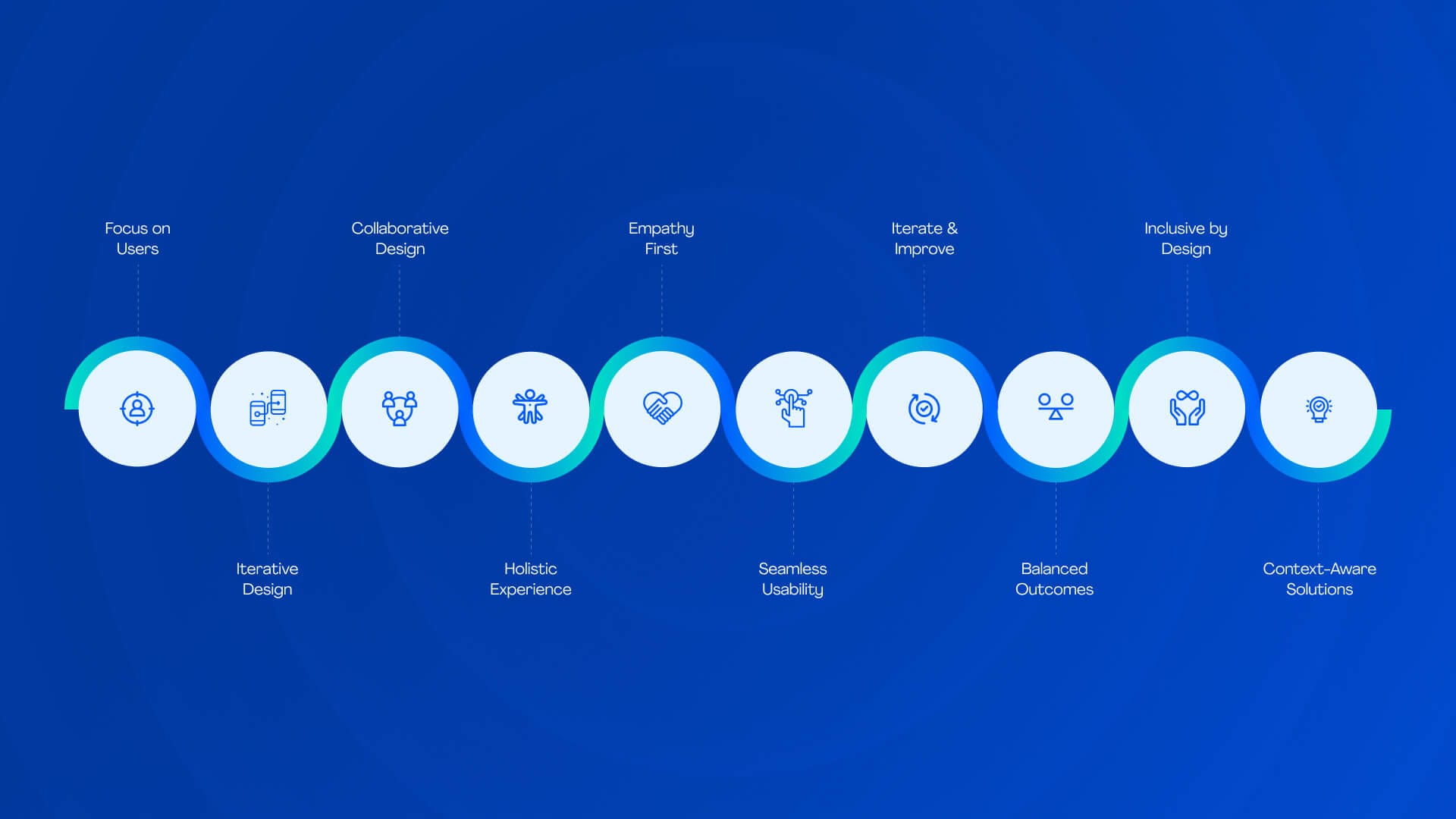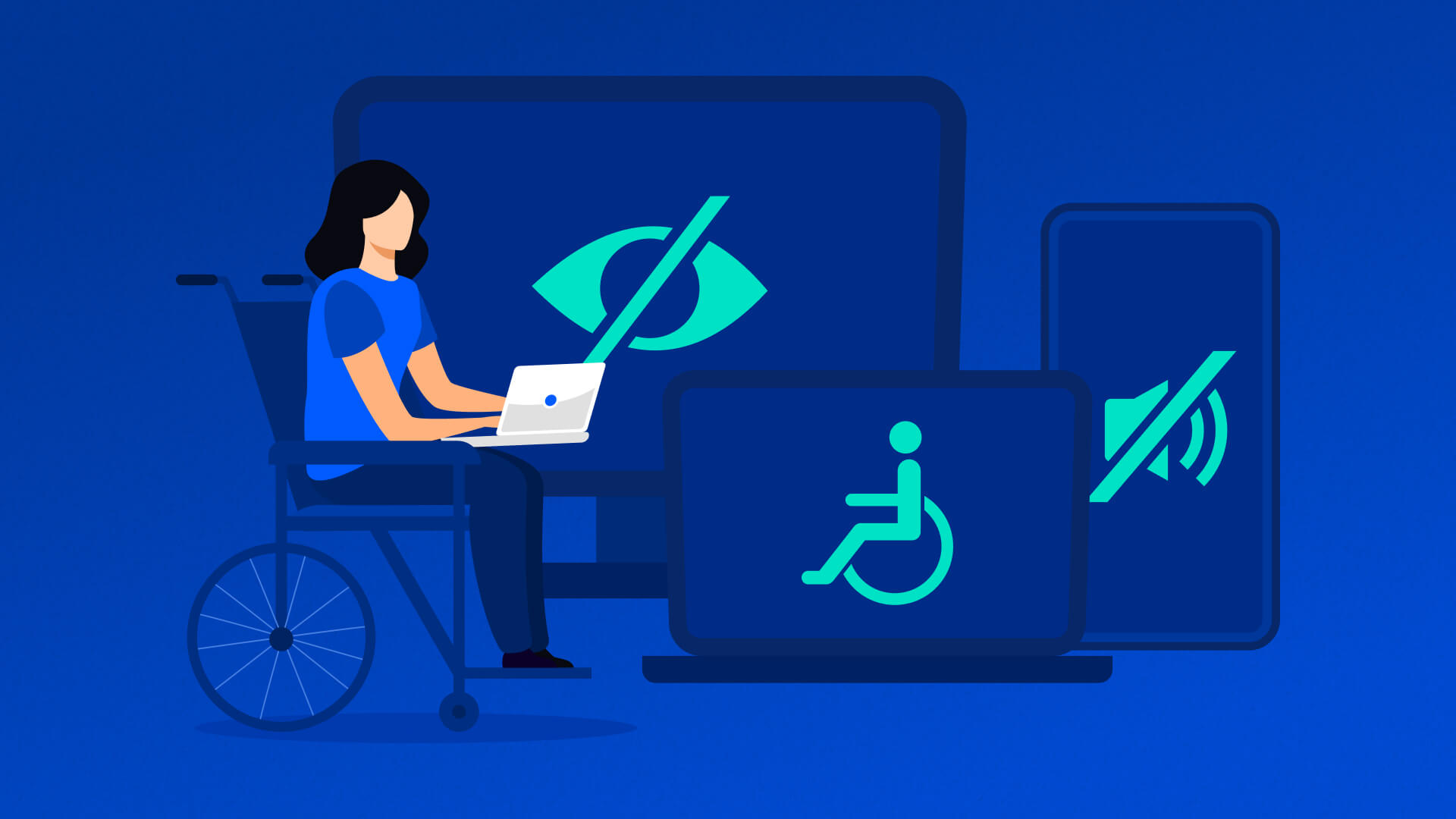Developing user-friendly software and apps is paramount in today's digital landscape. User and UX designers prioritise accessibility and inclusivity to create easy products for individuals of different abilities, ages, languages, and regions. Several prominent tech businesses, including Google, Apple, and Microsoft, have adopted inclusive design principles, highlighting the value of this strategy. Web accessibility is more than a trend; it's a need for companies, owing to the increasing number of lawsuits filed over inaccessible websites.
The blog delves into the importance of accessibility in UI and UX design, discussing the merits of inclusive product development and outlining fundamental principles of inclusive design. It includes a list of UI aspects like text, layout, media, and design that will help you make your product more accessible.
What is Accessibility in UX Design?
Accessibility in UX design entails making designs that may be used by every individual, regardless of their circumstances. Take navigation apps as an example; they should be user-friendly for everyone, including those with disabilities. All users, regardless of their abilities or conditions, should be able to access and benefit from a product or service, and that is why UX design prioritises accessibility.
It is of the utmost importance to develop assistive technologies that cater to the specific requirements of persons with disabilities. As an example, video subtitles assist viewers in a variety of settings, including those with hearing loss and those with noisy backgrounds.
To do this, user experience designers adhere to norms that ensure the design is advantageous for every user. Digital material, including text, photos, and videos, must be accessible and usable for all users. This includes individuals with temporary or situational constraints and motor, auditory, visual, or cognitive impairments.
Why is Accessibility Important in UX/UI Design?
There are several important reasons why accessibility in UX and UI design has become an important emphasis when creating digital applications:
Mandatory Laws
Legal requirements for accessibility exist in several nations. For example, laws such as the ADA, the Rehabilitation Act, and the EAA mandate that digital products be accessible to all users, including those with disabilities. Non-compliance might result in sanctions.
Reaching a Wider Audience
More people can utilise accessible items. Designing services and products with accessibility in mind means they are accessible to individuals with different abilities and backgrounds. If you are accessible, more individuals can take advantage of your offer.
Situational Efficacy
Several contexts benefit from accessibility features. With closed captions, a mother may view films quietly while holding her sleeping infant. Similarly, closed captioning allows viewers to comprehend video even when the surrounding noise level is high. These additions make the product more adaptable by increasing its usefulness in various settings.
Expanding Your Company
Businesses that make their offerings accessible may attract and retain more consumers. Accessible design may give companies useful input on the accessibility of their goods, which in turn opens up new market prospects. As a result of this input, new features or even whole new products adapted to individual demands might be created.
Enhancing Existing Apps
Availability isn't limited to new products. Making existing apps more accessible may increase their user base. By adding accessibility features, older products may be used and enjoyed by more people.
Increases Conversion Rates
To increase conversion rates, UI/UX design must be accessible. More people will become customers due to inclusive design's efforts to make the site user-friendly for everyone. The pleasure and engagement of users are increased, leading to higher conversion rates and overall company success, thanks to this smooth user experience.
Usability vs. Accessibility
In UX design, usability and accessibility are distinct but interconnected concepts. When we talk about usability, we mean to what extent a design is effective, responsive, and interactive in creating a pleasing user experience. The MEELS criteria—memorability, efficiency, learning curve, and satisfaction—are common ways to evaluate a design's usability.
However, people with impairments may have other demands than usability.
Accessibility ensures everyone has an equal experience by ensuring that designs accommodate users with specific requirements. It goes beyond just usability. The goal of accessible design is to ensure that all users, including those with cognitive and physical impairments, get the same degree of enjoyment from a design.
Microsoft Word, for example, has grammar checking and other features that make it more user-friendly for everyone. However, the application is accessible to those with dyslexia because of its predictive text capability.
An additional example would be an app that offers auto-translation services to those who speak different languages. Including accessibility capabilities, such as text-to-speech and speech-to-text tools, enhances usability for users who speak languages other than English. This ensures the application is accessible to anyone with trouble seeing or hearing.
Principles of Accessibility in UX Design
There are several important principles to consider when making UX/UI designs accessible. Following these principles will make digital products and services more accessible to people with disabilities:
Empathy
UX designers must prioritise empathy while creating accessible designs. Designers should be aware of and sensitive to their target demographic. For this, it's important to put oneself in the consumers' shoes and speak to them about their product.
Research on Users
Comprehensive user research is vital to ensuring accessible design. Designers must consider a wide range of users, each with unique physical and mental necessities. This research can collect useful insights and guarantee that all possible consumers' input is included throughout the design process, resulting in more inclusive solutions.
Context
A product's accessibility is greatly affected by its environment. For example, if a user uses a mobile app while walking or driving, designers must ensure it works well in all situations. Making designs that are accessible requires this, which increases complexity.
Navigation Control
Accessibility relies on effective navigation. Designers need to consider the requirements of all users, including those with assistive devices, and provide numerous navigation alternatives. That way, everyone may utilise the product in the best way for them.
Embracing Inclusion
To be inclusive, one must consider users of all abilities and work to make their products accessible to individuals worldwide. Designing prototypes with users' requirements in mind requires developing user personas and scenarios representative of a wide variety of consumers.
To further assist with accessible UX design, the Web Content Accessibility Guidelines (WCAG) include four basic principles called POUR:
- Perceivable: Ensure users perceive material differently, such as text replacements for non-text content and audio/video footage subtitles.
- Operable: Prevent designs that may induce seizures, make all features accessible via a keyboard, and provide people sufficient time to consume content.
- Understandable: Ensure the content is readable and certain, and provide users feedback to fix errors.
- Robust: Ensuring compatibility with multiple technologies, including future assistive aids, is crucial for robustness.
How to Make Your Designs More Accessible- Tips & Best Practices
To make your UI and UX design more accessible, consider the following:
Define Potential Users
Create a wide range of user personas that reflect your target demographic. Be inclusive by considering people with special needs in all audience groups.
Universally Compatible Design
Test your ideas on various devices and OSes to ensure they work properly. Your design must also be responsive since users use digital items on many platforms.
Make Use of Fonts That Are Easy to Read and Use
Use basic and easily readable fonts. Decorative typefaces should only be used for headers and titles.
Organise Content Logically
Build an information architecture that arranges data sensibly. This will make your design easier for people to navigate and understand.
Pick the Right Colour Contrast
Use colours with enough contrast to improve readability. However, certain users may need help to differentiate between specific hues.
Maintain a Uniform Style
Make sure your design is consistent throughout to facilitate browsing and avoid surprises. Consistent designs are also more accessible and simpler to grasp for those using mobility aids.
Provide Alternative Text for Media Files
Ensure all the pictures, videos, and animations include informative text. Thanks to alt-text, the information may still be accessible to the visually impaired with the aid of screen readers.
Consistently Use Relevant Anchor Text
Link wording should be more descriptive rather than lengthy URLs. Users using screen readers will find this more readable and accessible.
Offer Subtitles and Transcriptions
Make sure that every audio and video material has subtitles and transcriptions. This will benefit users who are non-native speakers or have hearing issues.
Reduce Animation
Reduce the number of animations and moving pictures used. Avoid graphics that flash, as they might be annoying to certain people.
Create an Accessible Design for Screen Readers
Make sure that screen readers can read your web content. Screen readers are essential for millions of individuals who use them daily.
Be sure to Make Use of HTML Headings and Tags.
If you want assistive technology to understand your material, you must appropriately utilise headers and HTML elements. Web and mobile app developers should pay close attention to this.
Add Shortcuts to the Keyboard
Provide keyboard shortcuts to make navigating simpler. Ensure that only a keyboard, mouse, or trackpad will allow access to your material.
Test with a Variety of Users
Perform usability testing with a varied set of users throughout the design lifecycle. To make it more accessible for everyone, add comments from people with varying cognitive and physical abilities.
Tips that must be kept in mind by UI / UX Designs:
- Ensure enough contrast by using the right colours and a minimum contrast ratio of 3:1 for bigger text.
- Avoid using only red and green by substituting text and unique symbols.
- Make sure the material is identifiable without colour.
- To make multimedia information easier to grasp, please use simple phrases.
- Make users aware of products that might cause anxiety or photosensitivity.
- Easy access to the homepage and quick selection choices should be available.
- To keep things simple, use proper space and organize your content using headers.
Conclusion
A good design takes into account what all of its users desire. As part of their vital job, UI/UX designers must consider their target audience's varied demands to improve user experiences. By adhering to accessibility guidelines, designers may eliminate discrimination and create products that are accessible to all users. Improving lives and making technology usable for everyone requires a commitment to accessibility, which goes beyond merely being a design requirement.
Frequently Asked Questions about Accessibility in UX/UI Design
When it comes to design, why is accessibility so crucial?
Accessibility improves the user experience for all users, increases audience reach, and guarantees inclusion.
When it comes to design, how important are accessibility principles?
To guarantee inclusive designs that enhance user experiences for everyone, accessibility principles remove discrimination.
What happens if designers don't think about accessibility?
Ignoring accessibility issues may lead to a decrease in product reach, legal consequences, and the exclusion of people with disabilities.
Ravi Talajiya
CEO of TheFinch
With over a decade of experience in digital design and business strategy, Ravi leads TheFinch with a vision to bridge creativity and purpose. His passion lies in helping brands scale through design thinking, innovation, and a deep understanding of user behavior.





















